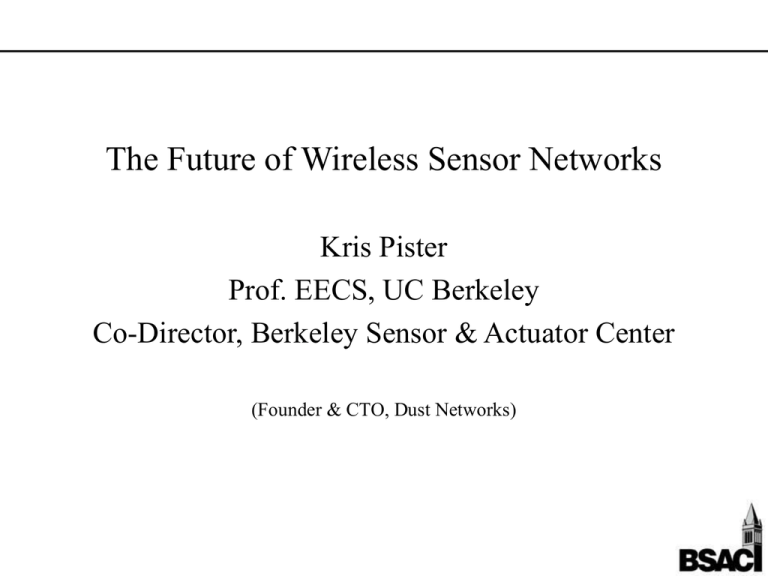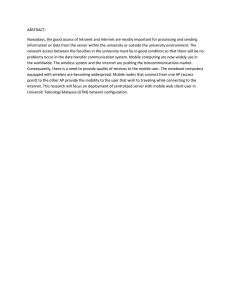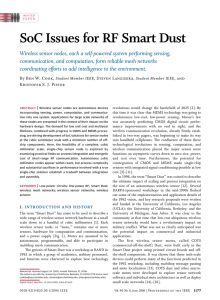The Future of Wireless Sensor Networks Kris Pister Prof. EECS, UC Berkeley
advertisement

The Future of Wireless Sensor Networks Kris Pister Prof. EECS, UC Berkeley Co-Director, Berkeley Sensor & Actuator Center (Founder & CTO, Dust Networks) Outline • • • • • The Past What Went Wrong Technology Status Applications Technology Directions BSAC IAB 1997 Autonomous Microsensor Networks with Optical Communication Links • • • • • PI: Kris Pister Source: Hughes (MICRO) Funding: $25k, $10k matching, 0% ovhd, Duration: 1 year Comments: Collaboration w/ Prof. Joe Kahn under separate MICRO BSAC IAB Spring 2000 COTS Dust GOAL: • Get our feet wet RESULT: • Cheap, easy, off-the-shelf RF systems • Fantastic interest in cheap, easy, RF: – – – – Industry Berkeley Wireless Research Center Center for the Built Environment (IUCRC) PC Enabled Toys (Intel) • Fantastic RF problems • Optical proof of concept Berkeley Demos – 2001 Motes dropped from UAV, detect vehicles, log and report direction Intel Developers Forum, live demo 800 motes, 8 level dynamic network, and velocity Seismic testing demo: real-time data acquisition, $200 vs. $5,000 per node vs. 50 temperature sensors for HVAC deployed in 3 hours. $100 vs. $800 per node. Cost of Sensor Networks Mesh Networking Computing Power Installation, Connection and Commissioning $ Sensors Time Sensor Networks Take Off! Industry Analysts Take Off! 800 700 Units (Millions) 600 $8.1B market for Wireless Sensor Networks in 2007 500 400 300 Wi-Fi nodes Handsets Wireless Sensor Nodes 200 100 0 2003 2004 2005 2006 2007 Source: InStat/MDR 11/2003 (Wireless); Wireless Data Research Group 2003; InStat/MDR 7/2004 (Handsets) Low Data Rate WPAN Applications Zigbee Zigbee2006 2003 Pro security HVAC AMR lighting control access control asset mgt process control environmental energy mgt BUILDING AUTOMATION CONSUMER ELECTRONICS PC & PERIPHERALS INDUSTRIAL CONTROL patient monitoring fitness monitoring TV VCR DVD/CD remote PERSONAL HEALTH CARE RESIDENTIAL/ LIGHT COMMERCIAL CONTROL mouse keyboard joystick security HVAC lighting control access control lawn & garden irrigation Barriers to Adoption Reliability Standards Ease of Use Power consumption Development cycles Node size 0% OnWorld, 2005 20% 40% 60% 80% 100% Dust Networks • Founded July 2002 • Focused on reliability, power consumption • Developed TSMP – Time Synchronized Mesh Protocol – >99.9% reliability – Lowest power per delivered packet 50 motes, 7 hops 3 floors, 150,000sf >100,000 packets/day Oil Refinery – Double Coker Unit • Scope limited to Coker facility and support units spanning over 1200ft • No repeaters were needed to ensure connectivity • Electrical/Mechanical contractor installed per wired practices • >5 year life on C-cell GW 400m Standards • IEEE 802.15.4 • Wireless HART • ISA SP100 Wireless HART booth at ISA Expo, Oct. 2006 The De-facto Standard 12 Manufacturers,1 Network – Dust Networks’ TSMP Emerson MACTek Yokogawa Siemens Siemens ABB Honeywell Phoenix Contact Endress+ Hauser Elpro Smar Pepperl+ Fuchs Excerpts from Customer Presentations at the Emerson Process Users Conference October 2-5, 2006 Streetline Networks Federspiel Controls HVAC System Retrofits Demonstrated Energy Savings: • 3.7 kWh/sf/yr • 0.34 therms/sf/yr • Higher savings than conventional retrofits Barriers to Adoption >99.9% Reliability Wireless HART, SP100 Standards “It just worked” Ease of Use 5-10 years Power consumption Complete networks Development cycles Node size 0% OnWorld, 2005 20% 40% 60% 80% 100% 2.4 GHz Transceiver Front End • Cook et al., ISSCC 2006 • Active Area: 0.8mm2 • Zero external RF components Radio Performance 25 X 20 With software: 10 years D cell IRX (mA) cc2420 15 X 10 cc1000 With software: 10 years coin cell 5 Cook 06 (300 mW) Molnar 04 (0.4mA) X Otis 05 (0.4mA) X 100k X 200k 300k Bit rate (bps) RF Time of Flight Ranging in a Coal Mine Tunnel Steven Lanzisera 70 60 Time of Flight (ns) 50 2 m Error 40 Measured Data 30 Ideal 20 1 m Error 10 0 0 2 4 6 8 10 Distance (m) 12 14 16 18 Mote on a Chip? (circa 2001) • Goals: – Standard CMOS – Low power – Minmal external components antenna Temp uP SRAM Amp ADC Radio ~2 mm^2 ASIC battery inductor crystal UCB Hardware Results ~2003 • 2 chips fabbed in 0.25um CMOS – “Mote on a chip” worked, TX only – 900 MHz transceiver worked • Records set for low power CMOS – ADC, Mike Scott, M.S. • 8 bits, 100kS/s • 2uA@1V – Microprocessor, Brett Warneke, PhD. • 8 bits, 1MIP • 10uA@1V – 900 MHz radio – Al Molnar M.S. • 100kbps, “bits in, bits out” • 20 m indoors • 0.4mA @ 3V Mote on a Chip, 2009 • Goals: – Standard CMOS – Low power – Minimal external components Zero antenna uP Security Temp Location Amp ADC Radio Time SRAM ~4 mm^2 ASIC battery inductor crystal Conclusion • 10 years later, a real market emerges • Reliable, low power, standards-based technology is no more expensive than junk • The lowest power radios in the world come from UCB/EECS/BSAC • The best software and algorithms for WSN come from UCB/EECS/BSAC





